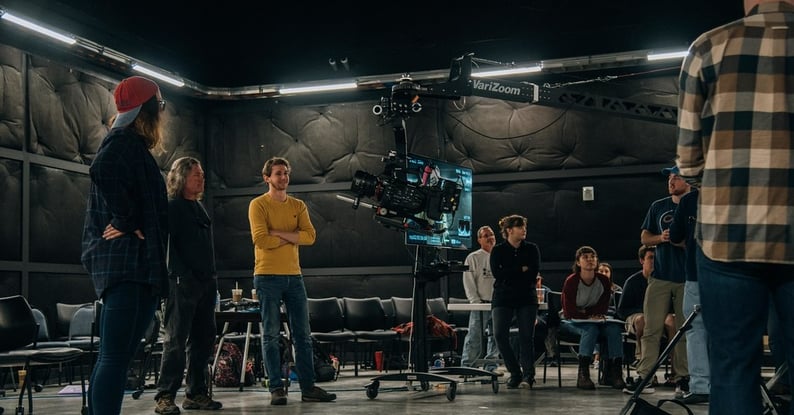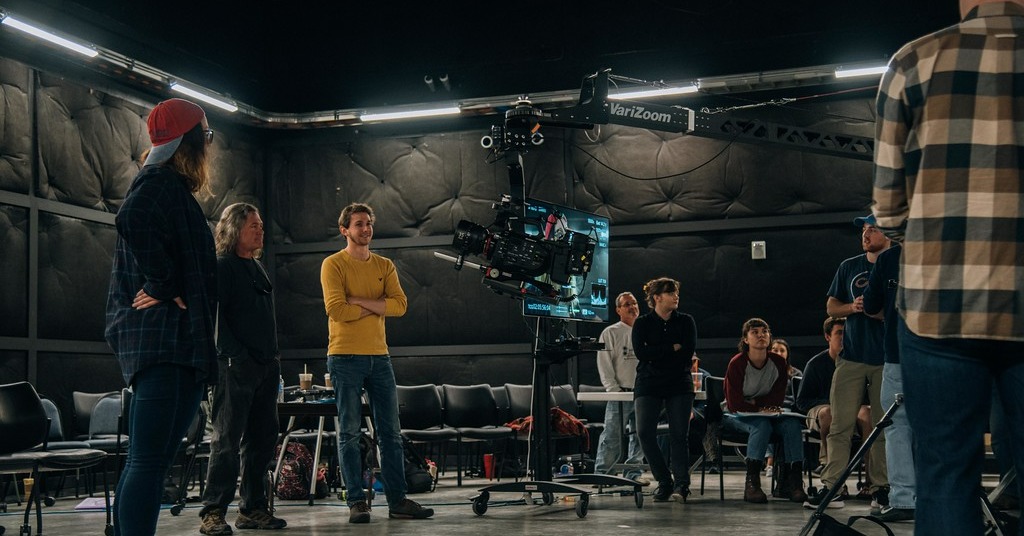From Dialog to Dubbing: The Role of Voice Synthesis Technology in Film Schools

Voice synthesis technology has come a long way in recent years. Its applications are expanding beyond virtual assistants and customer service bots. The education industry is actively using this technology to educate students in film schools, revolutionizing the way dialog and sound design are taught. In this blog post, we will explore the role of AI and voice synthesis in the film industry, discuss the benefits of using this technology in an educational setting, and how it can shape the future of film education.
Moreover, we’ll explore the transformative effects of generative AI, specifically enhancing the capabilities of AI voice synthesis in filmmaking and creating realistic learning experiences for aspiring filmmakers.
Emerging technologies revolutionizing the film industry
The film industry has always been at the forefront of technological innovation. Advances in visual effects, sound design, digital distribution, and now voice acting are actively changing the way movies are made and consumed. However, in recent years, a new wave of emerging technologies are revolutionizing the film industry in even more profound ways.
Virtual Production
Real-time rendering and motion capture technology, complemented by innovations in voice acting create immersive and interactive virtual environments for filmmakers to work in. In virtual production, dubbing and localization technology enrich the global cinematic experience. These AI voice changers offer filmmakers creative possibilities, pushing storytelling boundaries in the digital era.
Artificial Intelligence
AI and machine learning assist with various aspects of filmmaking, such as script analysis, casting decisions, and even creating entire scenes of motion pictures.
Augmented and Virtual Reality
AR and VR technology, coupled with AI dubbing, enables new forms of storytelling and audience engagement, giving way to immersive experiences that allow viewers to interact with fictional worlds in unprecedented ways.
Streaming and Digital Distribution
Advancements in streaming technology and digital distribution, alongside the integration of AI voice changer technology, are disrupting the traditional studio system, with new platforms and business models emerging.
Voice Synthesis
Voice synthesis technology is used in film production to create and modify dialog and create voice-over narration and character voices. This technology is a win-win as it effectively reduces costs while improving the efficiency of the production process. In addition to AI voice synthesis, dubbing and localization are crucial for global film accessibility, allowing cultural adaptation and language customization to resonate with diverse audiences worldwide.
These emerging technologies are transforming the film industry in exciting and unprecedented ways, with new opportunities for creativity, efficiency, and audience engagement. While there are challenges and risks associated with these new technologies, they also represent a promising future for the art and craft of filmmaking.
Synthesized voices for the media and entertainment industry
Disney is one of the main pioneers in the use of voice cloning technology. The media giant has been experimenting with synthesized voices for films, using machine learning algorithms to create realistic-sounding dialog for characters. This technology simplifies ADR and is also used to create new lines for characters without requiring additional recording sessions with actors.
The technology was used in the production of the Disney+ series The Mandalorian, where it helped to create the voice of a younger Luke Skywalker, the character made famous by Mark Hamill, in the show's second season finale. However, rather than casting a younger actor or using advanced de-aging techniques, the show's creators opted to use a combination of visual effects and a synthetic voice created by Respeecher. AI dubbing played a pivotal role in seamlessly matching the original voice of the character.
In the case of The Mandalorian, Respeecher used audio recordings of Mark Hamill from the original Star Wars trilogy to train their algorithm, showcasing the innovative synergy of visual effects and voice AI to create a and create a synthesized voice that sounded like a younger version of the character. This allowed for the character's dialog to be , with AI voice used to match the original voice of the character.
Respeecher has also been involved in the production of the highly anticipated Disney+ series, Obi-Wan Kenobi, recreating the voice of the most iconic movie villain Darth Vader. During the release of Episode IV: A New Hope, Darth Vader was voiced by actor James Earl Jones. Today however, he is 91 years old. And like everyone else, his voice has changed with age. Lucasfilm decided to restore the menacing timbre of Darth Vader with the help of new AI voice synthesis technologies. Generative AI played a key role in preserving Darth Vader's character, highlighting technology's transformative impact on maintaining authenticity and continuity in the entertainment industry.
Respeecher used archival recordings and a patented AI algorithm to create new dialogs of James Earl Jones’ voice. The company finished working on the project on the day that Russia began its full-scale invasion of its home-country Ukraine.
The benefits of speech synthesis in the film industry
There are several major benefits of synthesized voice in the film industry.
- AI voice can modify dialog, allowing for changes to be made without requiring additional recording sessions with movie actors. This can reduce production costs and improve the efficiency of the production process.
- The technology is able to create the voices of characters who are not physically present on set, such as characters who are animated or created using visual effects. This allows for greater flexibility in the production process and helps bring characters to life in new and innovative ways.
- Speech synthesis can also restore the voices of deceased actors, allowing them to appear in new productions without using archival footage or a different actor to portray the character. It is a valuable tool for filmmakers looking to pay tribute to actors who have passed away, showcasing the profound impact of AI voice synthesis on preserving the legacy of iconic voices in the film industry.
But voice cloning’s greatest benefit may be for indie films, as it allows for greater flexibility in the production process and has proven its ability to significantly reduce costs. By using voice cloning technology, indie animators can create high-quality voice performances without the need for expensive recording sessions or the involvement of numerous voice actors. This can help to level the playing field for indie and big-budget animators by allowing smaller studio animators to create engaging and immersive indie films on a tighter budget.
Moreover, popular voice actors can also benefit from voice cloning technology as it allows them to increase their presence in multiple projects simultaneously, without physically attending recording sessions. Voices, voice actors can give permission for production studios to clone their voices and use them for movie characters.
Voice cloning as a tool for film schools
For film schools, AI and voice cloning technologies introduce a number of creative opportunities, especially the integration of AI dubbing and localization. Students can use AI to analyze and improve their scripts. Voice cloning tools also excel at revealing insights into a dialog's emotional impact or how a scene should be voiced to improve its pacing and emotional resonance. Voice cloning technology can create temporary voiceover tracks for animatics or storyboards, allowing students to experiment with different performances and better understand how their dialog will sound in the final product. Additionally, voice cloning can create temporary placeholder dialog for live-action shoots, allowing students to focus on capturing the visual elements of a scene without worrying about the audio.
At the Academy of Interactive Education (AIE) in Canberra, film students now have access to cutting-edge technologies used in major productions like The Mandalorian or Thor: Love and Thunder, including AI dubbing and AI voice changer advancements. This non-profit vocational education provider is offering a world-class course using immersive visual effects technologies called StageCraft, an alternative to green screens.
This virtual production technology, increasingly common in high-budget film production, allows filmmakers to create a 3D virtual space similar to a video game setting. Actors perform on a real set with props, while the background is created using a gaming engine and displayed on curved screens. The virtual setting can then be recorded as the background of shots, moving as the camera does, creating the illusion of a real set.
In addition to this, AI is used to capture the movements of actors in a motion-controlled environment. The inclusion of dubbing and localization techniques in film school projects further prepares students for the now globalized nature of the film industry.
AI technology and film students
Students of the film industry not only need to work on honing their craft but also staying ahead of emerging tech like our own Voice Marketplace that is constantly redefining what is possible in the entertainment industry. The integration of voice AI is crucial to keeping pace with the evolving landscape. Doing so inevitably gives them a competitive edge in the job market. As the industry continues to evolve, new technologies are constantly emerging that change how films are made, distributed, and consumed.
By staying up to date with these emerging technologies, including AI voice changers, students can develop valuable skills that make them more attractive to potential employers. Developing a familiarity with these technologies will give students the tools they need to be more innovative and creative in their work, enabling them to push the boundaries of what is possible in the industry.
FAQ
The Voice Marketplace is a platform offering AI voice generators and advanced voice tech that streamline voice synthesis workflows. It enables creators to access affordable voice cloning, speech-to-speech outputs, and text-to-speech features for various needs, including small business voice solutions and creative projects.
Accent control in voice synthesis allows creators to adjust speech patterns, enabling accent-neutral voice solutions or specific accents in speech-to-speech outputs. This feature enhances voice synthesis workflows by providing more flexible, localized, and authentic-sounding voices, improving AI voice cloning and dynamic range enhancement.
Yes, AI voice generators in the Voice Marketplace offer small business voice solutions that reduce the need for expensive recordings. With features like accent adjustment technology and text-to-speech capabilities, businesses can easily create professional audio for marketing, customer service, and other communication needs at an affordable price.
The Per Minute plan offers an affordable way for small businesses and individual creators to access voice cloning technology. This plan allows users to pay only for the time they use, making voice synthesis workflows more accessible and cost-effective for everyone, with advanced AI voice generators and dynamic range enhancement.
The Voice Marketplace provides affordable voice cloning, AI voice generators, and tools for small business voice solutions. With features like accent adjustment technology and dynamic range enhancement, it supports startups and independent creators by enabling easy access to advanced voice tech for high-quality, professional results without breaking the bank.
Glossary
Voice Marketplace
A platform offering AI voice generators for affordable voice cloning, accent adjustment technology, and speech-to-speech outputs, enhancing voice synthesis workflows for small business voice solutions and dynamic range enhancement.
AI voice generators
Accent control technology
Dynamic range enhancement
Affordable voice cloning

- voice synthesis
- voice cloning
- voice conversion
- artificial intelligence
- AI voice synthesis
- film industry
- synthetic speech
- artificial intelligence (AI)
- text-to-speech (TTS) synthesis
- speech-to-speech (STS) voice synthesis
- synthetic voices
- voice cloning technology,
- voiceover
- synthetic film dubbing
- AI voice
- film industry technologies
- The Mandalorian
- Luke Skywalker
- AI voices
- voice assistants
- voice conversion technology
- voice cloning speech synthesis
- voice cloning solutions
- Ethics
- Mandalorian
- synthetic sound
- voice synthesizer
- voice actor
- voice-over industry
- voice actors
- AI voice generator
- Respeecher’s synthetic voices
- AI in filmmaking
- voice synthesis software
- sound designer
- Voice acting
- STS voice synthesis
- AI technology
- sound editor
- sound engineer
- film studios
- generative AI
- sound effects
- Voice synthesis technology
- film schools
- indie films
- Respeecher Voice Marketplace
- AI voice changer
- AI dubbing
- Film and Animation
- voice ai
- dubbing and localization
- synthethised voice,





